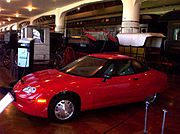
Electric motive power started with a small railway operated by a miniature electric motor, built by Thomas Davenport in 1835. In 1838, a Scotsman named Robert Davidson built an electric locomotive that attained a speed of four miles an hour. In England a patent was granted in 1840 for the use of rails as conductors of electric current, and similar American patents were issued to Lilley and Colten in 1847.[1]
Between 1832 and 1839 (the exact year is uncertain), Robert Anderson of Scotland invented the first crude electric carriage, powered by non-rechargeable Primary cells.[2]
By the 20th century, electric cars and rail transport were commonplace, with commercial electric automobiles having the majority of the market. Over time their general-purpose commercial use reduced to specialist roles, as platform trucks, forklift trucks, tow tractors and urban delivery vehicles, such as the iconic British milk float; for most of the 20th century, the UK was the world's largest user of electric road vehicles.[3]
Electrified trains were used for coal transport as the motors did not use precious oxygen in the mines. Switzerland's lack of natural fossil resources forced the rapid electrification of their rail network. One of the earliest rechargeable batteries - the Nickel-iron battery - was favored by Edison for use in electric cars.
Electric vehicles were among the earliest automobiles, and before the preeminence of light, powerful internal combustion engines, electric automobiles held many vehicle land speed and distance records in the early 1900s. They were produced by Baker Electric, Columbia Electric, Detroit Electric, and others and at one point in history out-sold gasoline-powered vehicles.
In the 1930s, National City Lines, which was a partnership of General Motors, Firestone, and Standard Oil of California purchased many electric tram networks across the country to dismantle them and replace them with GM buses. The partnership was convicted of conspiring to monopolize the sale of equipment and supplies to their subsidiary companies conspiracy, but were acquitted of conspiring to monopolize the provision of transportation services. Electric tram line technologies could be used to recharge BEVs and PHEVs on the highway while the user drives, providing virtually unrestricted driving range. The technology is old and well established (see : Conduit current collection, Nickel-iron battery). The infrastructure has not been built.
In January 1990, General Motors' President introduced its EV concept two-seater, the "Impact," at the Los Angeles Auto Show. That September, the California Air Resources Board mandated major-automaker sales of EVs, in phases starting in 1998. From 1996 to 1998 GM produced 1117 EV1s, 800 of which were made available through 3-year leases.
Chrysler, Ford, GM, Honda, Nissan and Toyota also produced limited numbers of EVs for California drivers. In 2003, upon the expiration of EV1 leases, GM crushed them. The crushing has variously been attributed to 1) the auto industry's successful Federal Court challenge to California's Zero-emissions vehicle mandate, 2) a federal regulation requiring GM to produce and maintain spare parts for the few thousands EV1s and 3) the success of the Oil and Auto industries' media campaign to reduce public acceptance of electric vehicles.
A movie made on the subject in 2005-2006 was titled Who Killed the Electric Car? and released theatrically by Sony Pictures Classics in 2006. The film explores the roles of automobile manufacturers, oil industry, the US government, batteries, hydrogen vehicles, and consumers, and each of their roles in limiting the deployment and adoption of this technology.
Honda, Nissan and Toyota also repossessed and crushed most of their EVs, which, like the GM EV1s, had been available only by closed-end lease. After public protests, Toyota sold 200 of its RAV EVs to eager buyers; they now sell, five years later, at over their original forty-thousand-dollar price.






No comments:
Post a Comment